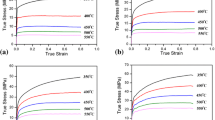Abstract
The temperature and strain-rate dependence of the yield and flow stresses of an age-hardened Fe-Si-Ti alloy, and a binary Fe-Si alloy, have been investigated in the temperature range 77 to 330 K. The parameters of activated deformation have been determined as a function of the precipitate dispersion and it is concluded that these parameters are unaffected by precipitation even when particles are sheared by dislocations, implying that bcc iron alloys cannot be dispersion strengthened at room temperature without making them even stronger, and hence more brittle, at lower temperatures. Work-hardening of all alloys is due to increases in the athermal component of the applied stress. The activation enthalpy at low effective stresses is larger than that for pure iron, indicating that silicon exerts a higher lattice friction stress due to its effect on the core asymmetry of screw dislocations in iron.
Similar content being viewed by others
References
R. Wasmuht, Arch. Eisenhüttenw. 5 (1931) 45.
J. P. Henon, C. Wache and J. Manenc, Mem. Sci. Rev. Met. 63 (1966) 99.
D. J. Abson, G. G. Brown and J. A. Whiteman, J. Austr. Inst. Metals 13 (1968) 61.
D. H. Jack, Met. Sci. J. 4 (1970) 22.
D. H. Jack and F. Guiu, “Proceedings of the 2nd International Conference on Strength of Metals and Alloys” (A.S.M., Cleveland, Ohio, 1970) p. 606.
D. H. Jack and R. W. K. Honeycombe, Acta Met. 20 (1972) 787.
L. Grånäs and B. Aaronson, Scripta Met. 2 (1968) 541.
H. Conrad and W. Hayes, Trans. ASM 56 (1963) 125.
D. H. Jack, Ph.D. Thesis, University of Cambridge (1969).
J. W. Christian, Proceedings of the 2nd International Conference on Strength of Metals and Alloys (A.S.M., Cleveland, Ohio, 1970) p. 31.
H. Conrad and S. Frederick, Acta Met. 10 (1962) 1013.
J. W. Christian and B. C. Masters, Proc. Roy. Soc. A281 (1964) 223, 240.
G. Alefeld, Z. Naturforsch. 17a (1962) 889.
F. Guiu, Phil. Mag. 20 (1969) 51.
R. Papaleo and J. A. Whiteman, “Effect of 2nd Phase Particles on the Mechanical Properties of Steel” (I.S.I., London, 1970) p. 22.
R. J. Arsenault, Scripta Met. 3 (1969) 419.
J. T. Michalak, Acta Met. 13 (1965) 213.
F. Guiu, Phys. Stat. Sol. 19 (1967) 339.
Author information
Authors and Affiliations
Rights and permissions
About this article
Cite this article
Jack, D.H., Guiu, F. Low-temperature deformation mechanisms in an Fe-Si-Ti alloy. J Mater Sci 10, 1161–1168 (1975). https://doi.org/10.1007/BF00541398
Received:
Accepted:
Issue Date:
DOI: https://doi.org/10.1007/BF00541398



